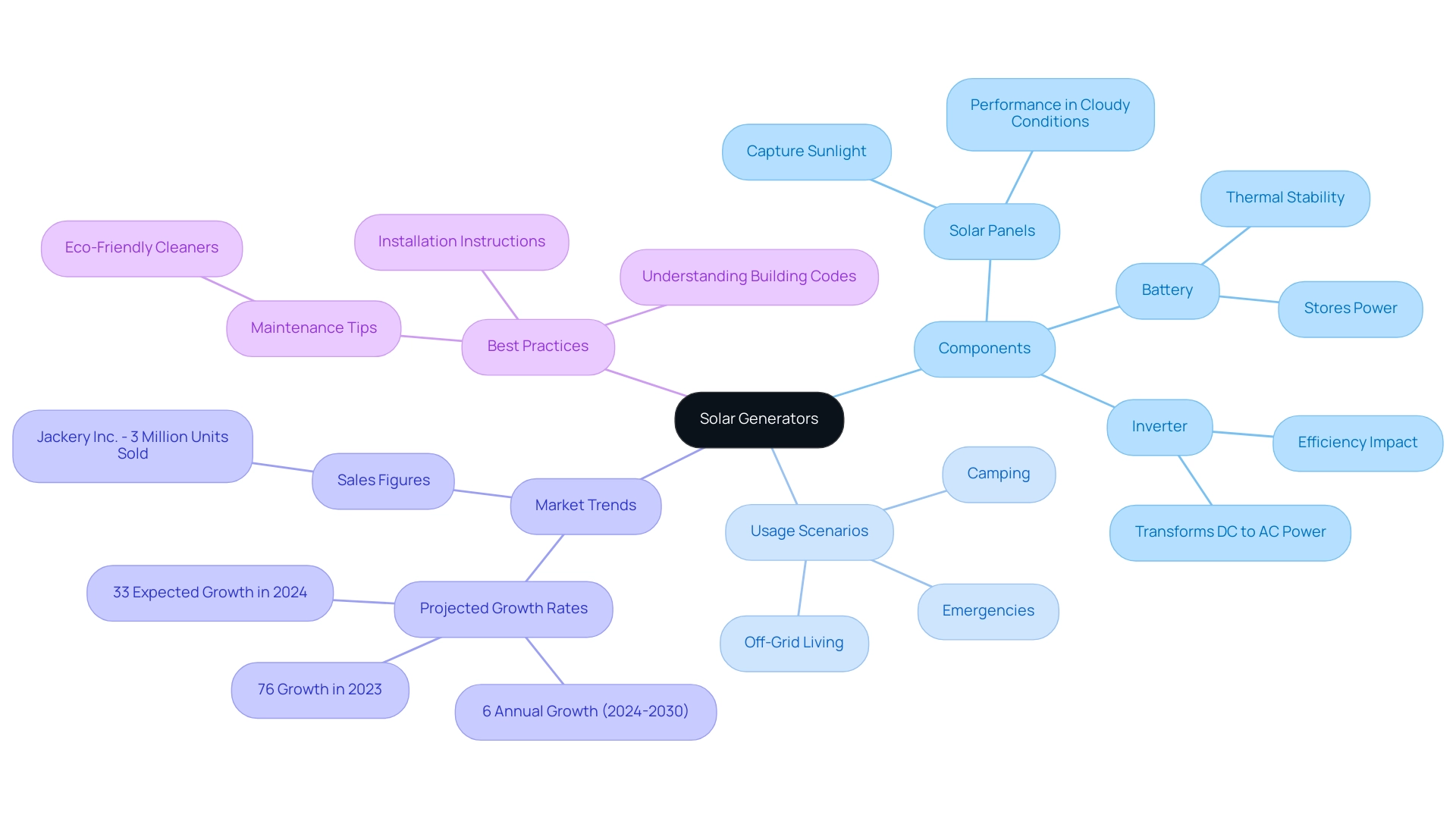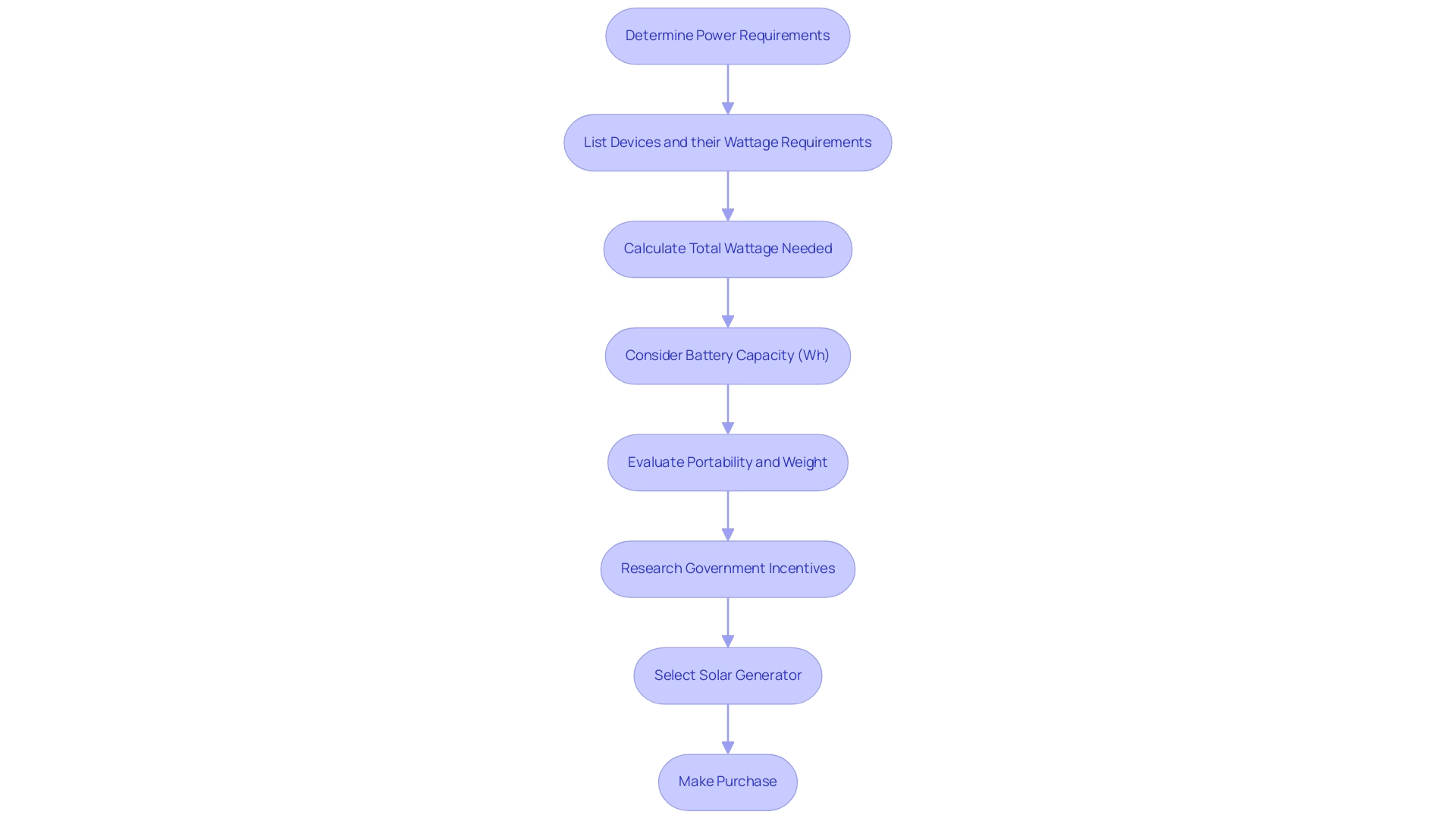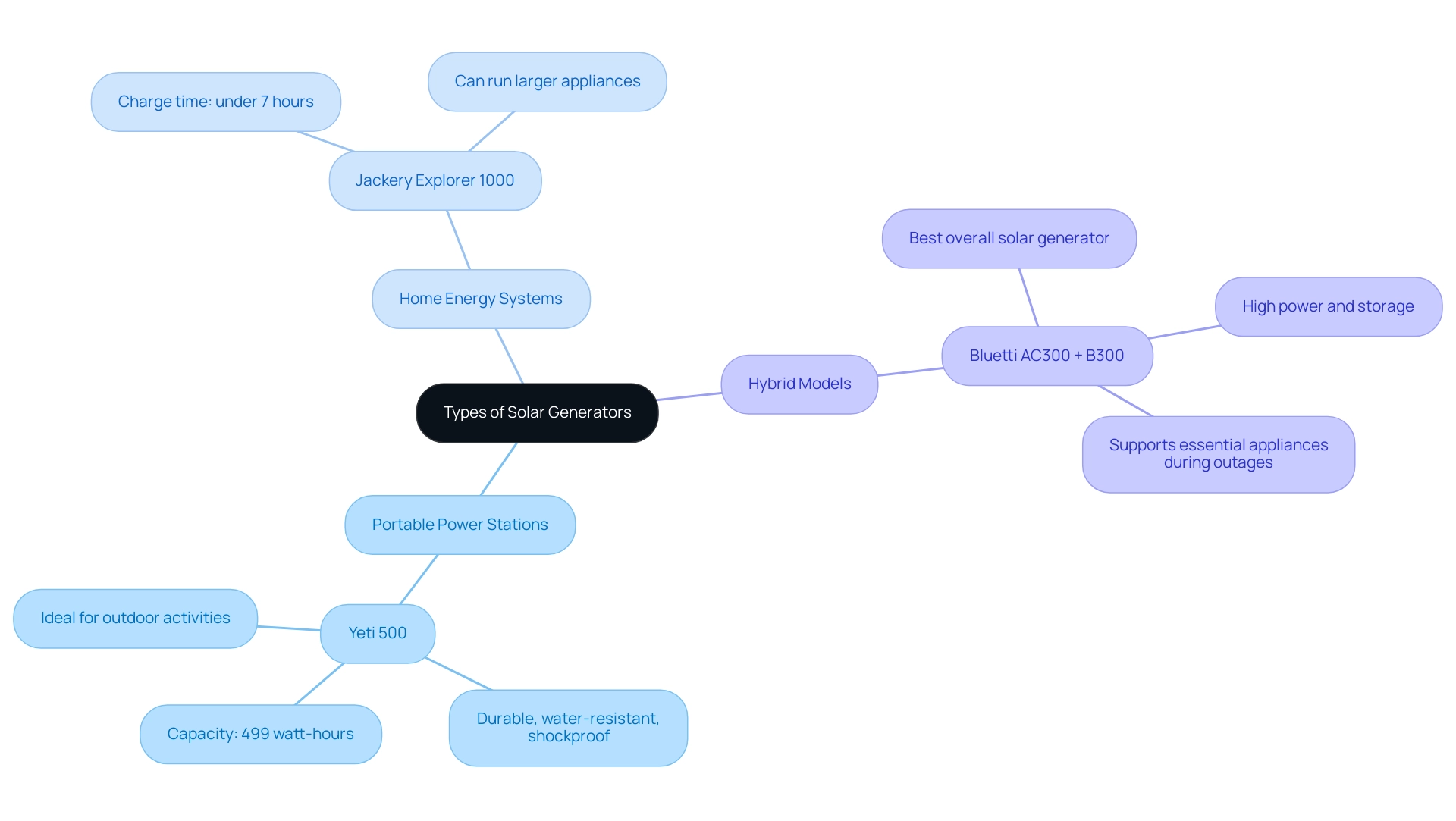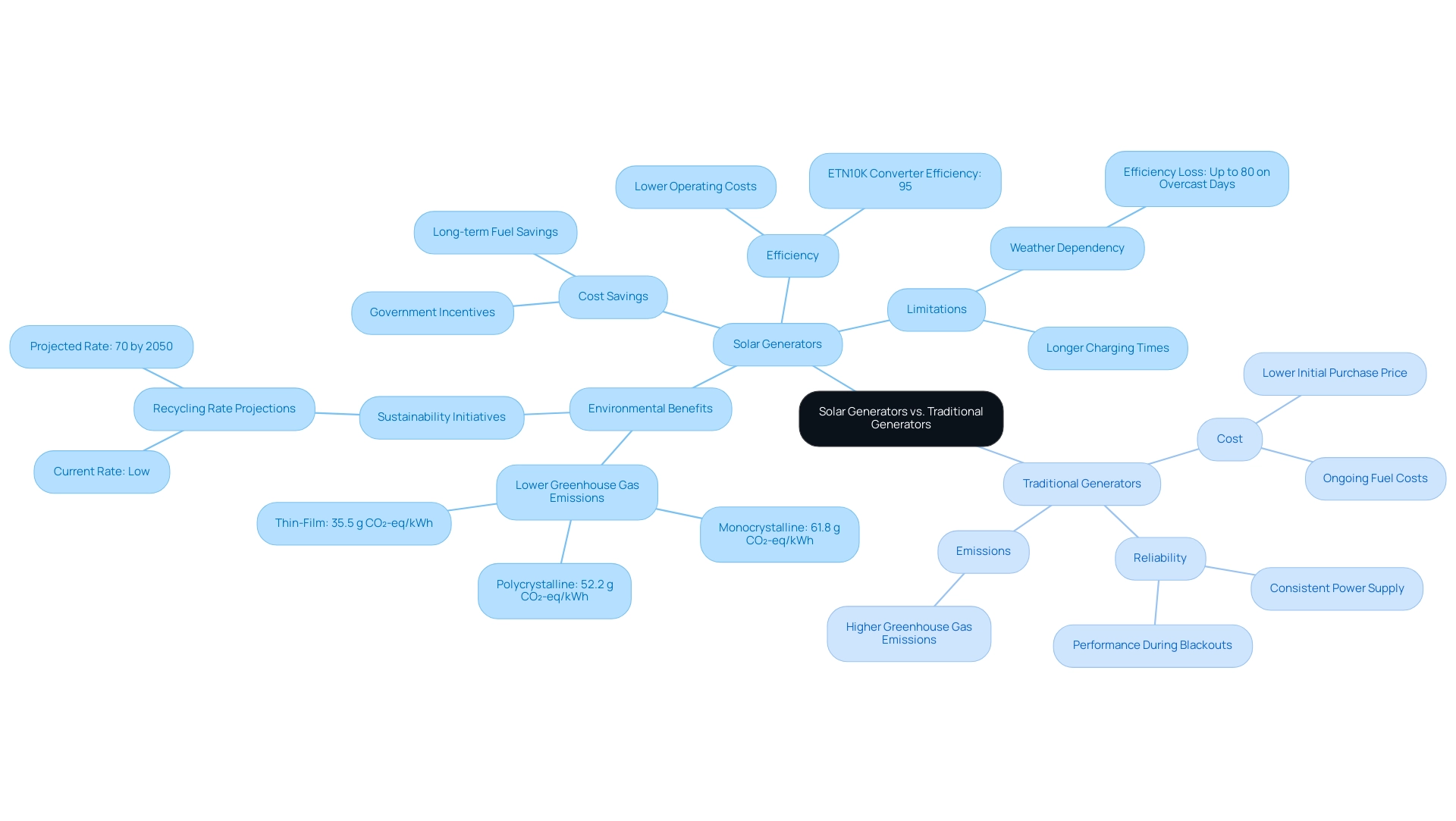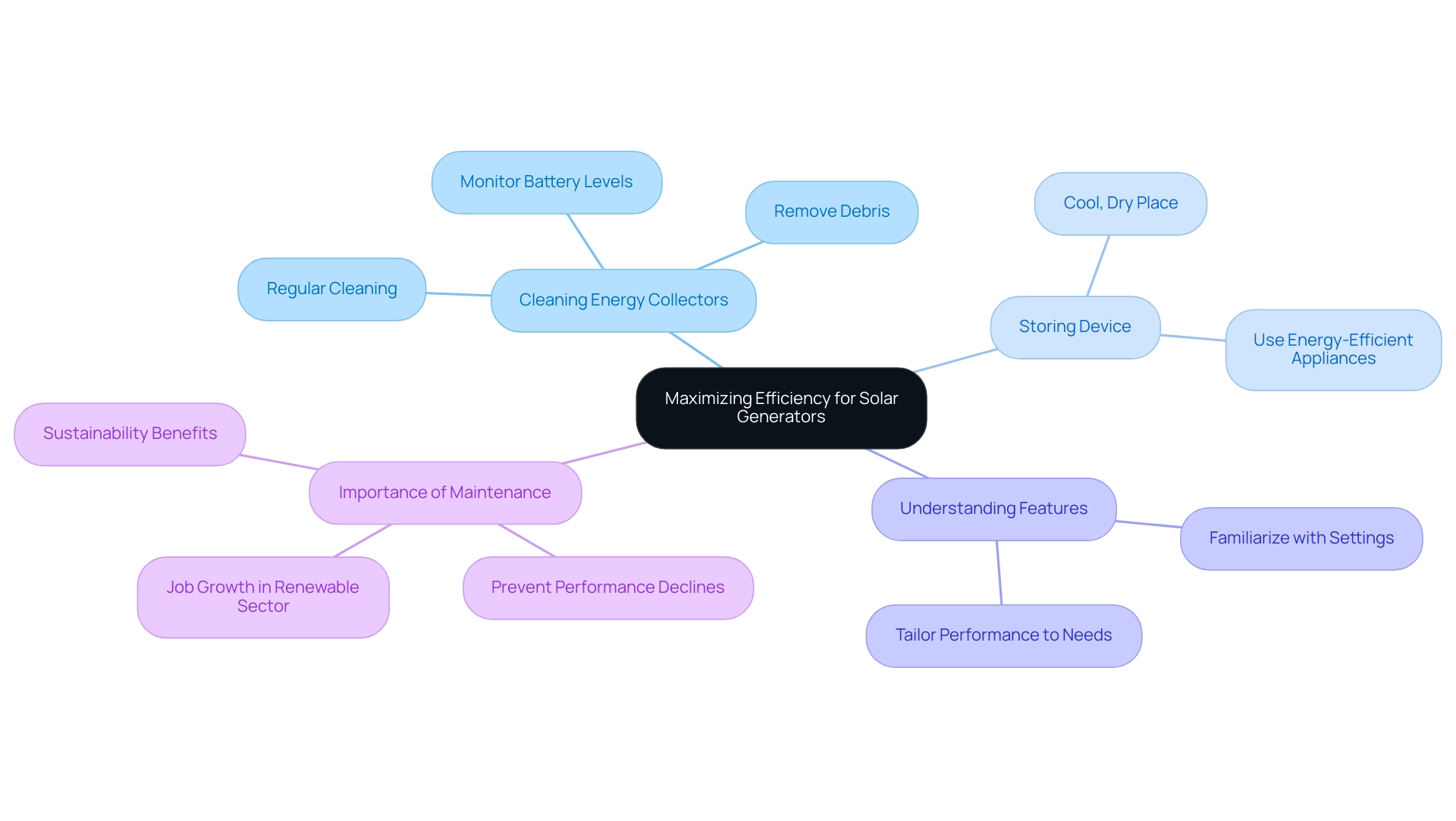Overview
Choosing and using a solar-powered generator involves understanding its components, assessing your power needs, and considering the efficiency of solar panels. The article emphasizes that by evaluating wattage requirements and investing in high-efficiency solar panels, users can maximize the generator’s performance and enjoy the benefits of renewable energy while reducing reliance on fossil fuels.
Introduction
As the world shifts towards more sustainable energy solutions, solar generators are stepping into the spotlight as a practical option for homeowners seeking to reduce their carbon footprint. These innovative devices harness the sun’s power to provide electricity, making them perfect for everything from camping trips to emergency preparedness.
However, with a variety of models and features on the market, choosing the right solar generator can feel overwhelming. This guide will explore essential factors to consider, compare solar generators with traditional options, and provide tips for maximizing efficiency, ensuring that homeowners can confidently navigate their solar journey and enjoy the numerous benefits of clean energy.
Understanding Solar Generators: Definition and Functionality
Solar power systems, including a generator that runs on solar power, are versatile, portable devices that harness the energy of sunlight to produce electricity, allowing you to operate your devices and appliances without relying on conventional fuel sources. At their core, these systems consist of three main components:
- Solar panels that capture sunlight (which are especially significant in cloudy conditions)
- A battery that stores the power
- An inverter that transforms the stored DC power into usable AC power
Grasping this interaction is crucial, as it directly influences the generator’s efficiency and how well it satisfies your particular power requirements.
These generators that run on solar power excel in diverse situations—whether you’re camping in nature, preparing for emergencies, or living off the grid. They present a generator that runs on solar power as a sustainable energy solution that not only reduces your reliance on fossil fuels but also offers peace of mind. Notably, advancements in sunlight technology are making these systems even more efficient.
For example, Bluetti’s recent launch of the sodium ion power generator NA300 demonstrates exceptional thermal stability and impressive quick charging abilities, paving the way for improved functionality in the upcoming years.
To maximize sunlight efficiency, particularly on overcast days, consider investing in high-efficiency energy collectors such as those from SunPower or LG, which are designed to perform well in suboptimal conditions. Furthermore, utilizing eco-friendly cleaners for photovoltaic systems can assist in preserving their efficiency, ensuring that dirt and debris do not hinder sunlight absorption.
As you evaluate your choices, investigating local companies in Stockton can offer further insights and support for your renewable energy journey. For homeowners looking to install photovoltaic panels, following step-by-step installation instructions is crucial for optimal performance. Additionally, as more property owners acknowledge the advantages of renewable power solutions, the market for photovoltaic generators, particularly the generator that runs on solar power, is anticipated to experience substantial expansion, with BNEF projecting an average increase of 6% annually from 2024 to 2030, following a 76% rise in 2023 and an expected 33% increase in 2024.
This corresponds with the broader trend in renewable resources, where companies like Jackery Inc. have already sold over 3 million units in just five years, establishing themselves as leaders in this burgeoning market. As Nicolas Fulghum, a Senior Data Analyst, observes, ‘At the current rate of capacity additions, China is on track to add 28% more photovoltaic capacity than in the previous year.’ Such developments reflect a growing shift towards embracing cleaner, more sustainable energy options, reinforced by best practices for selecting panel inverters and optimizing your energy requirements.
Additionally, understanding California’s building codes can further enhance the efficiency and compliance of your energy installations.
Choosing the Right Solar Generator: Key Considerations and Requirements
Selecting the appropriate solar device, including a generator that runs on solar power, is a crucial step for eco-conscious homeowners in Long Beach, and it begins with comprehending your power requirements. Begin by listing the devices you wish to power along with their wattage requirements. For example, a small refrigerator typically consumes around 100 to 200 watts, while a laptop usually requires about 50 watts.
Notably, a desktop PC can use 450 watts per hour when active and only 5.4 watts in standby mode, which could save you approximately £11.58 annually by remembering to turn it off.
Once you have this information, turn your attention to battery capacity, measured in watt-hours (Wh). A machine with a greater capacity enables you to operate your devices for an extended period before requiring a recharge, making it ideal for those seeking to enhance their autonomy.
Popular choices such as the Goal Zero Yeti 1500X and the Jackery Explorer 1000 provide strong features and dependable performance for home power storage. If you’re intending to take your power generator on camping trips or travels, don’t overlook the importance of portability and weight—these elements are essential for on-the-go power requirements. Furthermore, investigating government initiatives and incentives can greatly assist in your shift to renewable power.
For instance, California offers various rebates and tax credits for solar installations, including the California Solar Initiative, which can help offset costs for renters looking to invest in solar solutions. According to the U.S. Energy Information Administration, devices like televisions, cooking appliances, and consumer electronics account for 23% of home power consumption, emphasizing the importance of evaluating your power requirements carefully. Furthermore, trends in household power consumption indicate that while the number of homes is increasing, the average annual usage per home has declined thanks to advancements in efficiency and insulation.
With these fundamental components in mind, you’ll be well-prepared to choose a generator that runs on solar power, ensuring it meets your energy needs while aligning with your environmentally conscious lifestyle.
Exploring Different Types of Solar Generators: Which One is Right for You?
When choosing a renewable energy source, it’s essential to comprehend the range of choices available to discover the ideal match for your requirements. For example, portable power stations such as the Yeti 500, with a capacity of 499 watt-hours, are durable, water-resistant, and shockproof—perfect for outdoor activities, camping excursions, or just charging your devices in your backyard. While these portable devices are great for powering small gadgets, they provide significant convenience in a compact form.
In contrast, home energy systems concentrate on supplying backup power during outages. The Jackery Explorer 1000, for example, charges in just under seven hours and can run larger appliances when the power goes out. Additionally, hybrid models can utilize both renewable and traditional power sources, enhancing flexibility for homeowners.
As specialists stress, ‘The only sound you should hear from a photovoltaic system would come from the inverter,’ emphasizing their silent function. Moreover, investing in photovoltaic systems can result in long-term financial savings on electricity expenses and aid in environmental sustainability by decreasing dependence on fossil fuels. By researching and comparing these options, including high-performing models like the Bluetti AC300 + B300—praised as the best overall renewable energy source for its exceptional performance and capacity to support essential appliances during power outages—you’ll empower yourself to choose a power solution, such as a generator that runs on solar power, that seamlessly integrates into your eco-friendly lifestyle.
Additionally, exploring options like Tesla home chargers and understanding available government programs can further enhance your solar energy solutions.
Solar Generators vs. Traditional Generators: Pros and Cons
Eco-conscious homeowners have increasingly embraced solar power systems, especially those featuring a generator that runs on solar power, and for good reason. These systems not only promote environmental sustainability but also significantly decrease greenhouse gas emissions in comparison to conventional fossil fuel sources, which emit an average of:
- 61.8 g CO₂-eq/kWh for monocrystalline cells
- 52.2 g CO₂-eq/kWh for polycrystalline cells
In contrast, photovoltaic systems have a significantly lower carbon footprint, particularly with thin-film PV cells releasing only 35.5 g CO₂-eq/kWh.
With sunlight as their energy source, photovoltaic systems, which function as a generator that runs on solar power, incur lower operating costs, requiring minimal maintenance and functioning quietly—ideal for residential settings.
When considering costs, photovoltaic systems typically have higher upfront installation expenses compared to gas-powered units, but they offer long-term savings on fuel costs and maintenance. Gas-powered generators, while generally cheaper to purchase, incur ongoing fuel costs and higher emissions, which can accumulate over time. Nonetheless, it’s crucial to acknowledge the limitations of the generator that runs on solar power.
Their power output can be influenced by weather, especially on overcast days when sunlight collection efficiency may decrease significantly. For example, photovoltaic panels can lose up to 80% of their efficiency under overcast conditions. Charging times can also be longer than anticipated.
In contrast, gas-powered generators provide consistent power and reliability during blackouts.
Recent advancements in cleaning processes for high-efficiency cell production aim to further lessen the environmental impact of photovoltaic technology. While the recycling rate of PV modules remains low, it’s anticipated to reach up to 70% by 2050 under optimal conditions, suggesting a more sustainable future for energy from the sun. Additionally, government programs and incentives are increasingly available to help homeowners offset the initial costs of photovoltaic installations, making it a more accessible option.
To highlight these benefits, consider the case study of a local clinic in Tehran, which successfully implemented a microgrid system. This arrangement offered dependable power during outages for crucial functions, like illumination and medical devices, showcasing the durability and economic benefits of photovoltaic systems compared to conventional ones. As emphasized by Allouhi et al., the progression of photovoltaic technology presents both challenges and opportunities for homeowners.
Furthermore, the efficiency of the ETN10K converter, boasting around 95% operational efficiency in both directions, underscores the technological advancements that enhance the effectiveness and cost-efficiency of renewable energy systems. As you contemplate your options, think about how each type aligns with your values and practical needs, ensuring your choice benefits both your lifestyle and the environment.
Maximizing Efficiency: Tips for Using Your Solar Generator Effectively
To maintain your renewable energy system operating smoothly and effectively, here are some friendly tips to follow:
-
First and foremost, routinely cleaning your energy collectors is crucial; dirt and debris can obstruct sunlight and lessen efficiency—consider it as giving your collectors a little shower!
- Dust accumulation, bird droppings, and other debris can significantly hinder performance, so don’t overlook this vital step in your maintenance routine.
- Just like how you monitor your battery levels to prevent deep discharges that can harm battery life, staying on top of your solar panel cleanliness is key to longevity and efficiency.
-
Storing your device in a cool, dry place also contributes to its longevity—think of it as a cozy home for your equipment!
- When powering your devices, opt for energy-efficient appliances. Not only does this make your device’s job easier, but it also helps extend its runtime.
-
Becoming acquainted with your device’s features and settings can further enhance its performance, tailored to your unique needs.
- By adopting these best practices, you’ll ensure that your generator that runs on solar power remains a reliable and effective source of backup power for years to come.
- As Emily Walker from SunPower emphasizes, efficient equipment is essential; their photovoltaic modules feature an impressive 22.8% efficiency.
In today’s evolving energy market, the importance of regular maintenance is underscored by insights from researchers, indicating that even slight performance declines can accumulate over time.
- Data shows that the median loss rate for photovoltaic system performance is 0.75% per year, with 90% of systems encountering less than a 2% loss annually.
- By keeping your energy panels clean, you not only enhance their performance but also contribute to a more sustainable and environmentally friendly home.
With almost 9,000 new positions established in the U.S. in 2022 alone, the renewable sector is growing swiftly, indicating the increasing need for clean power solutions.
- Taking care of your generator that runs on solar power is just as crucial, so embrace these tips and enjoy the benefits of clean, renewable energy!
Conclusion
Investing in a solar generator is a significant move towards living sustainably, allowing homeowners to harness clean energy for various applications, from camping to emergency power. Understanding how these devices work—capturing sunlight to generate electricity—highlights their value.
Selecting the right solar generator starts with assessing personal power needs, battery capacity, and portability. With various options available, evaluating energy requirements and considering government incentives can lead to informed choices that enhance energy independence and decrease reliance on fossil fuels.
Solar generators provide notable environmental benefits and long-term savings compared to traditional gas-powered generators. While the initial costs may be higher, the reduced operating expenses and lower carbon emissions make them an attractive option for eco-conscious individuals. Knowing the advantages and limitations of different generator types ensures that selections align with personal values and practical needs.
To maximize efficiency, regular maintenance and smart usage practices are crucial. Keeping solar panels clean, storing the generator properly, and utilizing energy-efficient appliances can significantly enhance performance and lifespan. As the solar industry expands, adopting these practices not only supports personal sustainability but also contributes to a larger movement towards a greener future.
In essence, transitioning to solar energy is about more than just cutting carbon footprints; it’s about actively engaging in a sustainable future. With the right knowledge and resources, homeowners can confidently navigate their solar journey and fully embrace the benefits of renewable energy.



